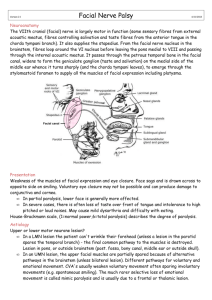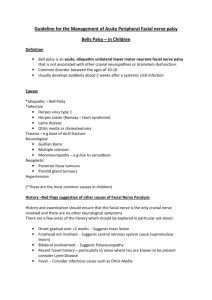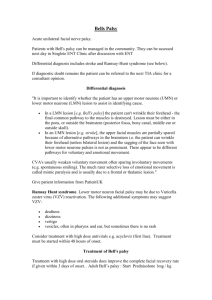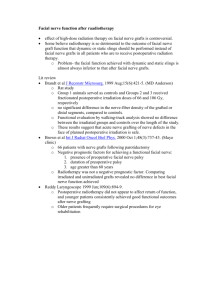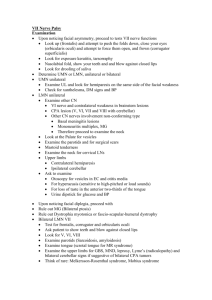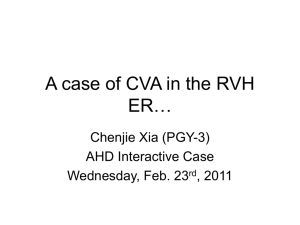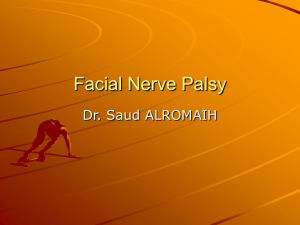CRANIAL NERVE VII
advertisement
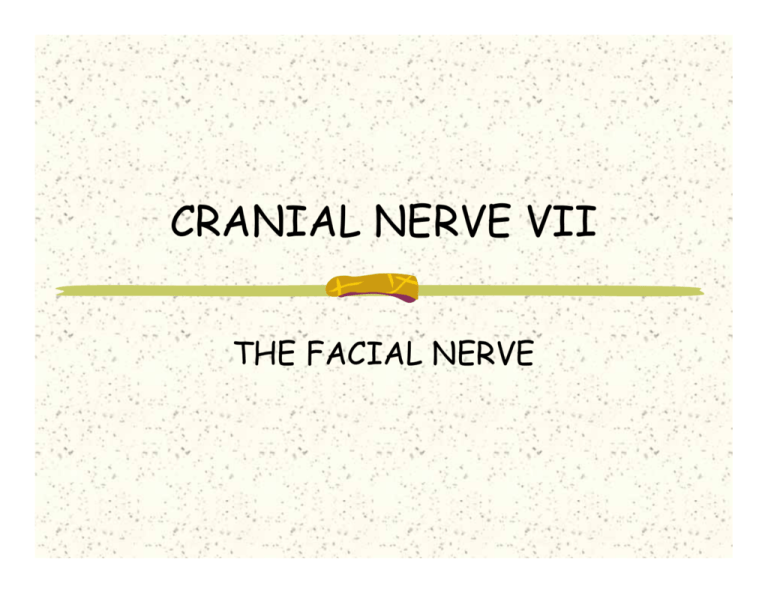
CRANIAL NERVE VII THE FACIAL NERVE ANATOMY Long complicated course: Cerebral cortex Internal capsule Brainstem : nucleus in the lower Pons Leaves brainstem at cerebello-pontine angle Internal auditory meatus – Canal CN VII CN VIII Nervus intermedius Internal auditary artery and vein ANATOMY (cont) ANATOMY (cont) Temporal bone Labyrinthine segment Horizontal segment Medial wall of middle ear Vertical segment mastoid Exits at stylomastoid foramen ANATOMY (cont) Turns to run through parotid gland Divides into branches ANATOMY (cont) Motor supply to face and a few sensory fibres to ear Secretomotor componentparasympathetic ANATOMY (cont) Fibres from contralateral hemisphere supply the nucleus in pons Motor fibres from ipsilateral hemisphere supplies the portion of nucleus that innervates the forehead UMN innervation of forehead - bilateral GENERAL Damage = facial weakness + cosmetic deformity Level of damage is determined by clinical picture UMN vs LMN Degree of recovery dependent on extent of damage AETIOLOGY UMN lesions = neurosurgeon/ neurologist LMN lesion = ENT surgeon damage along pathway of nerve CAUSES: NON TRAUMATIC Bell’s palsy – most common Herpes Zoster oticus Tumors Acoustic neuroma Parotid tumors Ramsey Hunt Syndrome CAUSES: NON TRAUMATIC Infections TB Mastoiditis Viral infections CSOM AOM CAUSES: CONGENITAL TRAUMATIC Difficult delivery Forceps Large infant CAUSES: CONGENITAL INHERITED Myotonic Dystrophy Autosomal dominant Muscle wasting + mental impairment CNVII palsy = early sign Albers-Schoenberg disease Autosomal recessive Affects bone metabolism Osteoperosis of bony canals CAUSES: CONGENITAL DEVELOPMENTAL Moebius syndrome Charge syndrome Oculo-auriculo- vertabral syndrome Congenital unilateral lower lip palsy CAUSES: ACQUIRED INFECTIONS Ramsey Hunt Syndrome Herpes Zoster oticus OME TB Mastoiditis Syphillis AIDS CAUSES: ACQUIRED NEOPLASTIC Schwannomas Acoustic neuroma CNVIII Parotid gland tumors CAUSES: ACQUIRED METABOLIC DM HT Pregnancy Autoimmune diseases hypothyroidism CAUSES: ACQUIRED NEURO GBS MS CAUSES: ACQUIRED TRAUMATIC Skull base #’s Iatrogenic Surgical injuries Sharp injuries APPROACH: TRAUMATIC AND NONTRAUMATIC LMN FACIAL NERVE PALSY TRAUMATIC: Post surgical Requires urgent attention ? urgent surgery Laceration to extra-temporal course Assess: Branches involved, how distal lesion is and degree of damage (paralysis, paresis and palsy) Urgent referral to ENT/ plastic surgeon TRAUMATIC (cont): Petrous temporal bone #’s: Characteristics: Hx of significant head trauma Haemotypanum / laceration of EAM #’s: Longitudinal (90%) Side blow; 20% facial nerve injury Transverse (10%) Frontal/occipital blow; 40% facial nerve injury May be bilateral, ass. with hearing loss TRAUMATIC (cont): Petrous temporal bone #’s… Mechanism of damage: Bony spicule Intraneural haematoma Neural contusion Nerve transection Possible complications: Facial nerve palsy Deafness (sensorineural/conductive) Vertigo CSF leakage (otorrhoea) TRAUMATIC (cont): Petrous temporal bone #’s: Management: thorough neuro assessment Immediate and complete palsy: refer to ENT CSF leakage: neurosurgical opinion Sensorineural deafness and vertigo (inner ear) Bedrest, labyrinthine sedatives and early mobilisation Guidelines for elective ENT referral: Conductive deafness >1/12 Partial or delayed facial nerve palsy Any signs of inner ear damage NON-TRAUMATIC: Mostly idiopathic (Bell’s) 90% resolve spontaneously Usually no significant sequelae NON-TRAUMATIC (cont): EXCLUSION CRITERIA FOR BELL’S: Signs of a tumour Bilateral simultaneous palsy Vesicles Involvement of multiple motor CN’s Hx or evidence of trauma Ear infection Signs of CNS lesion Facial palsy noted at birth Triad of IM (fever, sore throat, cervical LA) BELL’S PALSY: Unilateral facial palsy Acute onset Other sx: pain, hearing loss 85% begin to recover in 3 weeks Usually recover fully 15% recover after 3/12 Poor clinical result BELL’S PALSY (cont): Management: Prednisone 1mg/kg/day for 10 days Must start within 14 days of onset Acyclovir 400mg QID for 10 days Corneal protection: Ointments Eye drops Eye coverage HERPES ZOSTER OTICUS: Ramsay-Hunt syndrome Varicella zoster virus Poor prognosis Presents with severe otalgia Vesicles appear in 3-7 days Rx: steroids and acyclovir ACUTE OTITIS MEDIA: Palsy occurs in 2-3 days Rx: myringotomy and IV antibiotics If acute mastoiditis: do mastoidectomy Do not decompress nerve CHRONIS OTITIS MEDIA: Acute infectious exacerbations of CSOM IVI antibiotics and surgery Cholesteatoma surgery SPECIAL INVESTIGATIONS: RADIOLOGICAL TESTS: Not indicated for every pt High resolution CT MRI ELECTROPHYSIOLOGIC TESTS: Electroneuronography (EnoG): 2 weeks of onset of sx Measures and compares amplitudes of muscle summation potentials Current applied over main trunk of facial nerve Determines % degeneration ELECTROPHYSIOLOGIC TESTS (cont): Nerve excitability test (NET): Wave pulse applied to affected and unaffected facial nerve Thresholds for min facial responses recorded and compared 3-4mA difference abN ELECTROPHYSIOLOGIC TESTS (cont): Maximal stimulation test (MST): Stimulates ipsi- and contralateral facial muscles Use max stimulation to evaluate muscular response Subjective observation Electromyography (EMG): Determines muscle activity rather than nerve ELECTROPHYSIOLOGIC TESTS (cont): Audiometry: Evaluates conductive and SN hearing loss Co-existent in pt with CN VII palsies Branches: Greater Superficial Petrosal Nerve: Schirmer’s test: assess parasym innervation to lacrimal gland Nerve to Stapedius: stapedius reflex (audiometry) Chorda tympani nerve: test for taste CLASSIFICATION: HOUSE-BRACKMANN SCALE: I: N movement II: slight weakness, N symm and tone III: obvious weakness, no disfiguring weakness, N symm and tone, complete eye closure IV: obvious weakness, possible disfiguring asymm, N symm and tone, incomplete eye closure V: min movement and asymm VI: total paralysis, no movement, obvious asymm at rest TBH PROF’S CLASSIFICATION: Score each of the following of of 20: Forehead Eyes Nose Mouth Total score out of 80 Useful guide for follow-up and monitoring THANK YOU!!


